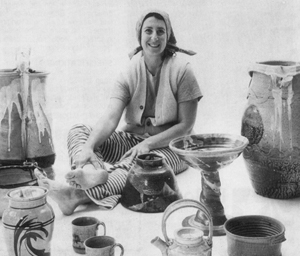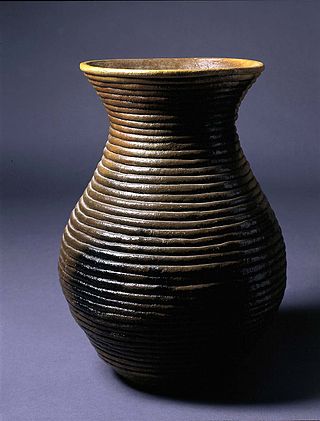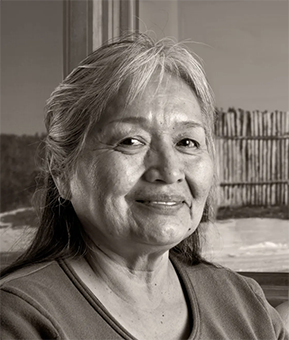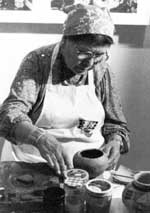Related Research Articles

The Taos art colony was an art colony founded in Taos, New Mexico, by artists attracted by the culture of the Taos Pueblo and northern New Mexico. The history of Hispanic craftsmanship in furniture, tin work, and other mediums also played a role in creating a multicultural tradition of art in the area.

Maria Poveka Montoya Martinez was a Puebloan artist who created internationally known pottery. Martinez, her husband Julian, and other family members, including her son Popovi Da, examined traditional Pueblo pottery styles and techniques to create pieces which reflect the Pueblo people's legacy of fine artwork and crafts. The works of Maria Martinez, and especially her black ware pottery, are in the collections of many museums, including the Smithsonian, the Metropolitan Museum of Art, the Denver Art Museum, and more. The Penn Museum in Philadelphia holds eight vessels – three plates and five jars – signed either "Marie" or "Marie & Julian".

Elizabeth Woodman was an American ceramic artist.
Marie Zieu Chino (1907–1982) was a Native American potter from Acoma Pueblo, New Mexico. Marie and her friends Lucy M. Lewis and Jessie Garcia are recognized as the three most important Acoma potters during the 1950s. Along with Juana Leno, they have been called "The Four Matriarchs" who "revived the ancient style of Acoma pottery." The inspiration for many designs used on their pottery were found on old potsherds gathered to use for temper. Together they led the revival of ancient pottery forms including the Mimbres, Tularosa and other various cultures in the Anasazi region. This revival spread to other potters who also accepted the old styles, which led to new innovative designs and variations of style and form.

Art of the American Southwest is the visual arts of the Southwestern United States. This region encompasses Arizona, New Mexico, and parts of California, Colorado, Nevada, Texas, and Utah. These arts include architecture, ceramics, drawing, filmmaking, painting, photography, sculpture, printmaking, and other media, ranging from the ancient past to the contemporary arts of the present day.

Faye Tso (1933–2004) was a Navajo potter and herbal medicine healer. Her pieces are known for their nontraditional imagery of corn maidens, warriors, and dancers, whereas Navajo pottery typically has little decoration. Born in Coal Mine Mesa, Arizona, Tso was relocated with other Navajos to Tuba City, Arizona in 1974 because of a land dispute between the Navajo and Hopi tribes. She returned to dig her clay at Coal Mine Mesa, where she also gathered pinon from which she extracted the pitch resin used to coat and seal her Dineh pottery. In 1990, the Arizona Indian Living Treasures Association designated Tso as a living treasure. Her husband and son are medicine men and use Tso's pots in their ceremonies.

Louise Rose Goodman is a Navajo folk artist and ceramicist.
Lisa Holt and Harlan Reano are a husband-and-wife team of Pueblo potters and artists from northern New Mexico. They have been making pottery together in 1999, they use traditional Cochiti pottery techniques and create modern work.
Anita Fields is an Osage/Muscogee Native American ceramic and textile artist based in Oklahoma. She is an enrolled citizen of the Osage Nation.

Jane Osti is a native Cherokee artist. She specializes in traditional Cherokee pottery with unique embellishments and designs. In 2005, Osti was one of the youngest Cherokee artists to be appointed as a Living Treasure by Cherokee Nation. Currently, Osti teaches and creates her own pottery in her studio in downtown Tahlequah.
Irene Hardy Clark is a Navajo weaver. Her matrilineal clan is Tabaahi and her patrilineal clan is Honagha nii. Her technique and style is primarily self-taught, incorporating contemporary and traditional themes.
Alice Williams Cling is a Native American ceramist and potter known for creating beautiful and innovative pottery that has a distinctive rich reds, purples, browns and blacks that have a polished and shiny exteriors, revolutionizing the functional to works of art. Critics have argued that she is the most important Navajo potter of the last 25 years.

Christine McHorse, also known as Christine Nofchissey McHorse, was a Navajo ceramic artist from Santa Fe, New Mexico.

Mamie Deschillie (1920–2010) was a Navajo folk artist.

Anna Mitchell was a Cherokee Nation potter who revived the historic art of Southeastern Woodlands pottery for Cherokee people in Oklahoma. Her tribe designated her as a Cherokee National Treasure and has works in numerous museum collections including the Smithsonian National Museum of the American Indian, the Museum of Fine Arts, Boston, and the Fred Jones Jr. Museum of Art, among others.

Mary Holiday Black was a Navajo basket maker and textile weaver from Halchita, Utah. During the 1970s, in response to a long-term decline in Navajo basketry, Black played a key role in the revival of Navajo basket weaving by experimenting with new designs and techniques, pioneering a new style of Navajo baskets known as "story baskets."
Melissa Cody is a Navajo textile artist from No Water Mesa, Arizona, United States. Her Germantown Revival style weavings are known for their bold colors and intricate three dimensional patterns. Cody maintains aspects of traditional Navajo tapestries, but also adds her own elements into her work. These elements range from personal tributes to pop culture references.

Daisy Hooee Nampeyo was a Hopi-Tewa potter. She studied at École des Beaux-Arts. Hooee taught pottery making on the Zuni reservation and helped preserve the traditional techniques she learned from her grandmother, Nampeyo.
Ida Sahmie is a Navajo potter. Sahmie combines Hopi traditional pottery making methods and Navajo iconography in her work. She has work in the Smithsonian American Art Museum and the Wheelwright Museum of the American Indian.

Black-on-black ware is a 20th- and 21st-century pottery tradition developed by Puebloan Native American ceramic artists in Northern New Mexico. Traditional reduction-fired blackware has been made for centuries by Pueblo artists and other artists around the world. Pueblo black-on-black ware of the past century is produced with a smooth surface, with the designs applied through selective burnishing or the application of refractory slip. Another style involves carving or incising designs and selectively polishing the raised areas. For generations several families from Kha'po Owingeh and P'ohwhóge Owingeh pueblos have been making black-on-black ware with the techniques passed down from matriarch potters. Artists from other pueblos have also produced black-on-black ware. Several contemporary artists have created works honoring the pottery of their ancestors.
References
- 1 2 3 4 "Betty Manygoats". Smithsonian American Art Museum: Renwick Gallery. Smithsonian American Art Museum. Retrieved 29 September 2019.
- 1 2 3 Congdon, Kristin G.; Hallmark, Kara Kelley (2012). American Folk Art: A Regional Reference, Volume 1. ABC-CLIO. ISBN 9780313349362 . Retrieved 29 September 2019.
- 1 2 3 Rosenak, Chuck and Jan (1990). Museum of American Folk Art Encyclopedia.
- 1 2 "Betty Manygoats". Collections. Smithsonian Institution. Retrieved 29 September 2019.